Traditional water purification methods are prominently used in rural communities worldwide. Traditional ways to purify water include some rudimentary methods to remove impurities. Long years ago, people utilized the available resources like sand, cloth, stone etc. to purify water.
Those basic methods only make the water quality acceptable for drinking purposes. But, somewhere these old methods prove to be less efficient in killing microbes.
Thus, traditional water purification methods do not match the quality standards for drinking water quality. But, a simple disinfection step kills all water-borne pathogens and it can make the water potable for human consumption.
This post explains the meaning of water purification and some traditional water purification techniques. Also, you will get to know the advantages and limitations of each method.
Content: Traditional Water Purification Methods
What is Water Purification?
Water purification is one of the processes that come under the category of environmental biotechnology. It employs several techniques to remove impurities from the raw water coming from different streams, rivers, lakes etc.
We somehow know that water from different reservoirs isn’t always clean, or it may contain solid particulates and water-borne pathogens. So, water purification techniques make sure to remove such impurities from the raw water.
Water purification generally involves physical, biological and chemical means to make the water potable by separating impurities from the raw water. But, people in ancient times used some simple or rudimentary ways to purify all the kinds of impurities in water.
Traditional Methods of Water Purification
Ancient civilians in Africa, Asia, India and Europe have introduced the traditional water purification methods. Traditional techniques eliminate visible contaminants (leaves, twigs, and other suspended particles) from the raw water.
But, these are not successful in removing harmful water-borne pathogens from the water and need disinfection. This problem provided the foundation for developing modern water treatment methods.
Nowadays, raw water goes through a wastewater treatment plant that involves a series of operations ( filtration, sedimentation and disinfection), making the water fit for human use.
Earlier, people practised different methods to filter the large particles, separate small suspended particles and disinfect the water, as illustrated below.
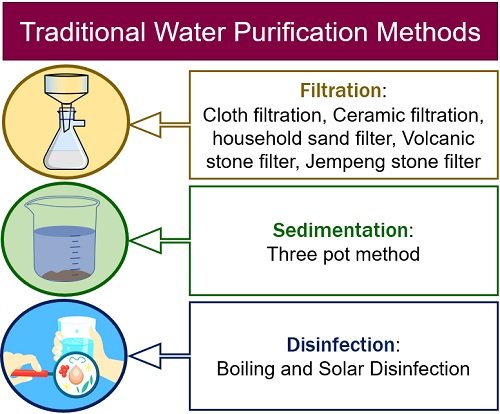
Traditional Ways of Water Filtration
Simple filtration methods filter the raw water using cloth, clay pots, sand, and stone filters.
Cloth Filtration
It’s a simple way to filter water that only requires a piece of cloth. For water purification, silk fabric is best.
- Take large cotton or silk cloth and fold it two-three times.
- Then, keep the cloth on the mouth of the pot and tie it through a rope.
- After that, you can pour the turbid water into the earthen pot.
- You can transfer the filtrate to another clean earthen pot and keep it aside.
- After filtrate separation, clean and dry the cloth under proper sunlight.
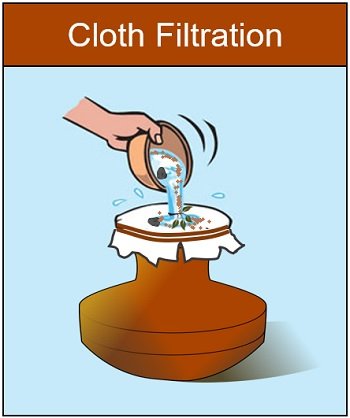
Advantages
- It is simple and cost-effective.
- Cloth filtration is most suitable for the filtration of well water.
- You can take old clean clothes to filter water multiple times.
Disadvantages
- It can only separate large and suspended substances from the water and is unable to remove water-borne pathogens.
- The method is not suitable for filtering highly turbid water.
- It is necessary to wash the cloth each time after the filtration. Also, any hole or tear in the fabric will hamper the filtration process.
Ceramic Filtration
It uses a clay pot that is mixed with husks or sawdust. Then, fire a pot in a kiln, after which sawdust or husks burn away. This step results in the formation of tiny pores in a clay pot.
- Keep a pot over the container. Noting that, the mouth of a pot should be large enough so that it does not slip into the container.
- Pour the muddy water into the ceramic pot.
- Then, filtered water seeps out of the pot downwards to the container.
- You can pull out water from the container by rotating the spiget.
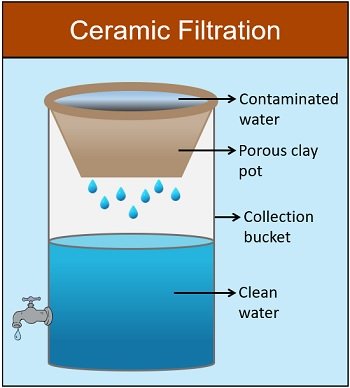
Advantages
- It’s simple to install, operate and maintain.
- It is a very cost-effective method to remove turbidity and pathogens.
- Provides safe storage to prevent re-contamination.
- Waste products like rice husks, sawdust, etc., are readily available in rural areas. So, ceramic pot filters are easy to produce.
Limitations
- You need to clean the filter by gently scrubbing the surface.
- Replacement of the filter is necessary every 1-2 years, as fine cracks may hamper the filtration.
- Ceramic filters are ineffective in removing chemical, heavy metal contaminants and pathogens.
- Waterflow through the ceramic filter is very slow, i.e. the method is not ideal for water filtration on a larger scale.
- The small suspended particles in the turbid water may clog the pores of the ceramic filter. Thus, it becomes necessary to clean a clay pot to avoid clogging.
- Handling ceramic filters requires a lot of care as they are fragile.
Household Sand Filter
It is the simplest form of a sand filter and serves as a pre-treatment for water purification.
- Take one earthen pot and put some gravel.
- Then, add a layer of coarse sand, and above this, add a layer of fine sand.
- Keep this pot on top of any clean container with a spigot at the bottom.
- Then, pour raw water into the earthen pot. You will notice that water will quickly get filtered through layers of sand and gravel.
- The filtrate then seeps into the container.
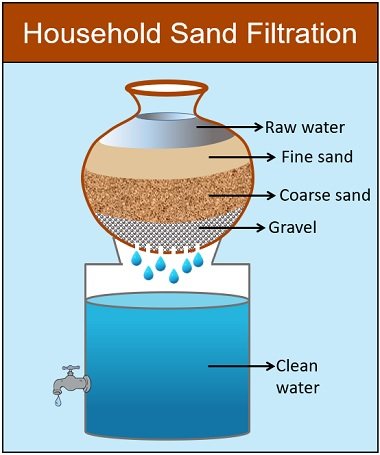
Advantages
- The setup is easy to install.
- It is cost-effective.
- The water flow rate through a sand filter is fast, i.e. you can filter more raw water through this method.
- It efficiently removes larger contaminants and some pathogens.
Disadvantages
- Sand filter is unable to eradicate pathogens and chemical contaminants.
- This method is only efficient for pre-treatment of raw water, i.e. requires further treatment to make water fit for consumption.
Volcanic Stone Filter
Purifying turbid water using a volcanic stone filter is very similar to the ceramic filter. But, it differs in how the volcanic stone filter purifies the water using rock pores.
- A cone-shaped basin is produced from limestone or volcanic stone and serves as a water filter.
- Fill the basin with water, and the water slowly starts to filter through the porous rock.
- Then, water goes into the earthen pot at the bottom.
- Such volcanic stone basins can filter about 1 litre of water every 6 hours.
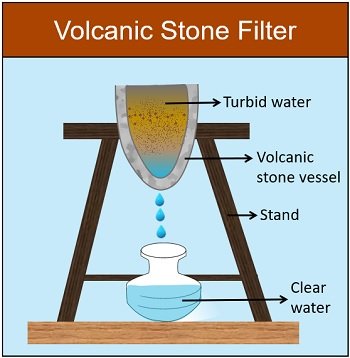
Disadvantages
- The method has a prolonged rate of filtration.
- You won’t get volcanic stones everywhere, i.e. the method can be carried out in specific countries like Peru (South America), where volcanic rocks are readily available.
Jempeng Stone Filter
Saringan Batu Jempeng from Bali, Indonesia, has pioneered this water filtration method. It is effective in purifying muddy water from wells or irrigation channels. Now, this method is somewhat different from the methods we discussed above. Here, the container is in dirty water, unlike all the methods discussed above.
- Jempeng stone filter is made of a porous material (cadas). The wall of a jempeng stone filter is 10-12 cm thick.
- Then, set up the jempeng stone filter over a stone-supporting gravel bed in any water channel carrying muddy water.
- The running muddy water passes through the pores of the jempeng filter, and the mud gets collected inside.
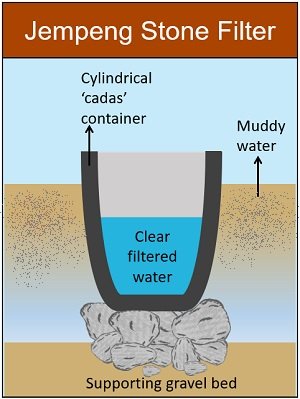
Advantages
- It is very cost-effective.
- It can treat highly turbid water as well.
Disadvantages
- The filtration rate is relatively low.
Sedimentation
The three-pot method is commonly used to separate suspended small particles in filtered water.
Three Pot Water Method
It is the method that cleans dirt from the water. Water may contain small particulate matter even after filtration. So, small dirt particles settle at the bottom over time through sedimentation.
- Take three earthen pots and add raw or muddy water to the first pot on the first day. Then, leave the pot undisturbed for a day so that the dirt settles at the bottom.
- On the second day, carefully transfer the above-filtered water to the second pot by following the same procedure. Wash the first pot to remove all the settled dirt.
- On the third day, transfer the filtered water from the second pot into the third pot and wash the pot-2.
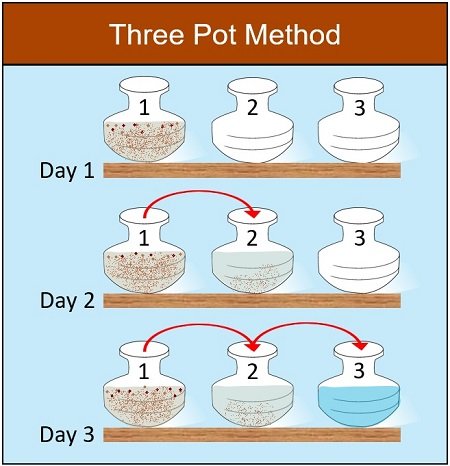
Thus, Pot-1 contains muddy water, Pot-2 contains clear water and Pot-3 contains drinking water that needs disinfection.
Advantages
- It is easy to use method.
- It requires low cost.
- Three pot method is good at reducing dirt in the water and is considered ideal for regular use in rural areas.
Disadvantages
- It cannot remove all smaller suspended particles, pathogens and chemical contaminants from the raw water.
- Three pot water method needs disinfection before consumption.
Traditional Ways of Water Disinfection
Boiling and solar disinfection are the common, traditional ways of disinfecting water.
Boiling
It is one of the traditional and highly effective methods for disinfecting water.
- You can add filtered water to the boiling pan.
- Heat the water until it reaches a rolling boil (at 100 °C).
- For effective disinfection, boil the water for 10-15 minutes to kill all the micro-organisms.
- Cool the water for some time at room temperature and then drink it as per use.
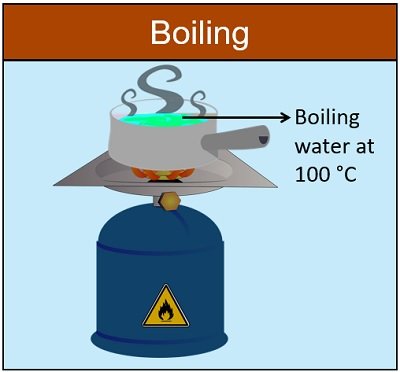
Advantages
- It’s very effective in killing all pathogens.
Disadvantages
- Boiling requires fuel and its operation cost depends on the type of fuel used.
- Water tastes flat after boiling.
Solar Disinfection
SODIS uses solar radiation to disinfect or remove pathogens from the water.
- You can either take transparent glass bottles or plastic bottles made from polyethylene terephthalate (PET).
- Then, fill the filtered water in these bottles and place them either on roof tiles or iron black tin under direct sunlight.
- Keep these bottles under exposure to solar light for a minimum of 6 hours on sunny days. This helps in killing pathogens in the water.
- You can directly use water from the bottle to avoid re-contamination.
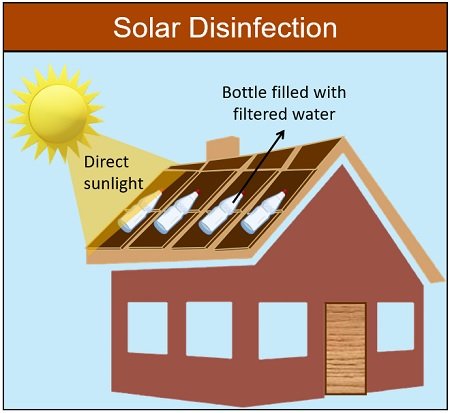
Advantages
- It is the easy and oldest method of disinfecting water.
- The method is cost-effective because it uses natural sunlight or avoids the usage of any fuel.
- Radiations of sunlight effectively remove harmful water-borne pathogens.
- Suitable for disinfecting water in small quantities with low turbidity.
Disadvantages
- SODIS system is not efficient on cloudy days, rainy days and at night.
Conclusion
People over the years have regularly practised some ordinary water purification methods to match the quality standards of drinking water. In the present-day situation, the amount of drinkable water is only 1.2 per cent on the earth. Nowadays, it has become more necessary for us to purify water than it has ever been in ancient times.
Due to increasing population and global warming, potable water will become harder and harder to come by. So, using some of the above techniques, you can also purify water at home.
As we moved into this new and different house, we noticed that the water isn’t that clean to use for drinking. My father thinks we need water purification so that we can have clear and pure water to drink in our house. So it’s awesome that this article actually talked about how we can make water potable.